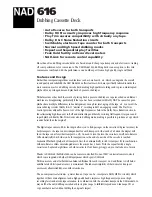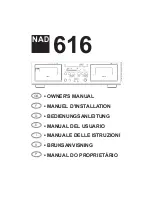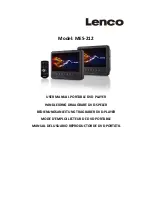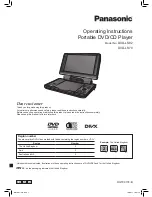
Analog: Sound that has not been turned into numbers. Analog sound varies, while digital sound has specific
numerical values. Analog sound is available when you use the red and white audio jacks on your equipment.
These jacks send audio through two channels, the left and right.
AUDIO OUT Jacks: Jacks on the rear of the DVD Player that send audio to another system (TV, Stereo, etc.).
The jacks are red and white.
CD: Compact Disc.
Chapter: A part of a Title.
COAXIAL jack: Sends digital audio to a Stereo, allowing you to adjust the volume at the Stereo.The Stereo
must have a Coaxial In jack.This connection provides the 5.1 channel surround sound as heard in movie
theaters. The COAXIAL jack on the rear of the DVD Player is black.
Color system: There are various systems for transmitting television signals, for example PAL, SECAM, and
NTSC. NTSC is the most common color system in the United States of America.
Component Video Y Pb Pr Jacks: The Video Out jacks on the rear of the DVD Player that send high-quality
video to a TV that has Component Video In jacks. The jacks on the DVD Player are red, blue, and green.
Digital: Sound that has been converted into numerical values. Digital sound is available when you use the
Player’s COAXIAL jack, which sends audio through multiple channels instead of two channels as analog does.
Dolby Digital: A surround sound system that provides 5.1 channel sound as used in movie theaters.
DVD: Digital Video Disc.
Letter Box: Widescreen format; a TV aspect ratio setting (4:3). Displays the video in full-width, with black bars
at the top and bottom of the TV screen.This format is similar to seeing a movie in a theater. If the Disc does
not include a letter box format, selecting letter box may have no effect. Some DVDs are two-sided, with one
side playing in widescreen format and the other side playing in a normal (pan & scan) format.
Pan & Scan: A TV aspect ratio setting (4:3). Displays the video with full-height picture with one or both sides
of the picture trimmed to fit on your TV screen. Some movie companies refer to this as “reformatting the
picture to fit your TV screen.”
PBC: Playback Control. A special feature on some Video CDs/Super Video CDs that enables interactive use.
PCM: Pulse Code Modulation. A digital audio encoding system.
RGB: Red-Green-Blue. A top-quality video connection where red, green, and blue components of the picture
are carried through separate wires.This also is referred to as the component video connection.
S-Video: Produces a clear picture by sending separate signals for the luminance and the color.
Title: A unit of recording on a DVD.
VCD: Video Compact Disc.
VIDEO OUT Jack: Yellow jack on the rear of the DVD Player that sends video (picture) to a TV.
Widescreen: A TV aspect ratio setting (16:9). Displays the video appropriately when you connect the DVD
Player to a widescreen TV.
48 Glossary





































